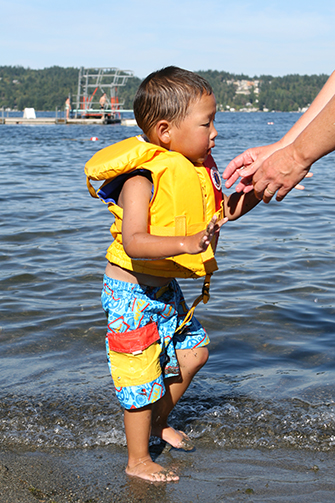Water Safety
Layers of protection for water safety
In Washington state, drowning is the second leading cause of unintentional injury death for children and teens age 1 to 17. So how can you keep your little ones safe? By using layers of protection while in, on or around the water.
Learn to swim
Swim lessons provide a good base layer of protection from drowning. Taking part in formal swim lessons has been shown to reduce the likelihood of childhood drowning death. Check about lessons at your local pool or life-guarded beach. Upgrade your child’s swimming skills each year, making sure they can eventually float and tread water for at least one minute.
Supervise fun in and around water
Adult supervision is a layer of protection that is a serious job. When you can, swim only in areas where there are lifeguards. Actively watch your child when they are in or near water – this means being within touching distance of young children at all times.
Since most drownings occur quickly and quietly, focused supervision is needed for older kids, too, so save the magazine or book for when the kids are taking a break from the water. Assign an adult “water watcher” to prevent drownings at group events near the water, such as PEPS reunions or lakeside picnics. The water watcher should remain alcohol-free and actively watch the children in or near the water.
 Wear life jackets
Wear life jackets
Life jackets offer another layer of protection. Children, teens and adults should always wear life jackets when on a boat, raft or inner tube, and when swimming in natural bodies of water, like lakes, rivers and the ocean. Young children should also wear them when playing in or near the water and when on docks. Check for proper fit and make sure they are U.S. Coat Guard- approved.
Follow these recommendations for when to wear a life jacket even if you and your child know how to swim. There’s no time to put on a life jacket if you fall out of a boat or misjudge your swimming ability. Even good swimmers can struggle in cold water or currents. The extra safety and warmth of a life jacket can be the difference between a safe rescue and a deadly outing.
More layers of protection to keep your family safe
Water Safety USA was recently established by a group of national organizations, both governmental and nongovernmental, to share aligned messaging about water safety and drowning prevention. Water Safety USA provides these additional tips for how to stay safe at pools and water parks, in natural bodies of water, and at home:
- Swim with someone else
- Avoid underwater breath-holding activities and games
- Be aware of hazards in the water
- Enter natural bodies of water feet first
- Obey posted signs and flags
- Learn rip current safety
- Avoid alcohol and drugs
- Empty all tubs, buckets, containers and wading pools immediately after use
- Keep toilet lids closed and use toilet seat locks
- Remove toys from around the pool after use and cover hot tubs
- Install four-sided, four-foot fencing around pools and spas, and use self-closing, self-latching gates
Know what to do in an emergency
Most drownings can be prevented, but it’s important to be prepared and know what to do if an emergency does occur. Learn child and adult CPR, have quick access to a phone to call 911 while near water, and learn safe ways to rescue others without putting yourself in danger.
Learn more
Visit Seattle Children’s drowning prevention page to learn more about water safety.
About the Author
 Heather Cooper is a community health educator in Marketing and Communications at Seattle Children’s Hospital. She’s the editor of Good Growing and my Good Growing, a contributor to On the Pulse blog, and a health and safety consultant for hospital communications. Outside of work, she does her best to keep her 17-year-old twins healthy, safe and happy!
Heather Cooper is a community health educator in Marketing and Communications at Seattle Children’s Hospital. She’s the editor of Good Growing and my Good Growing, a contributor to On the Pulse blog, and a health and safety consultant for hospital communications. Outside of work, she does her best to keep her 17-year-old twins healthy, safe and happy!
Document Actions